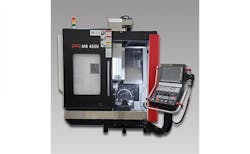Bridge-Type Machining Center
Methods MB 450U Simultaneous 5-Axis Bridge-Type Machining Center is loaded with features and capabilities for efficiently manufacturing complex parts with a high degree of quality, reliability, and accuracy. Due to the FANUC 31i-MB5 control, this machine is able to perform full five-axis precision machining of challenging parts, significantly reducing the need for multiple setups. Thanks to the control that is available exclusively to Methods, due to its partnership with FANUC, Methods Machining Centers are the only machines from Taiwan that can offer 5-axis simultaneous.
The FANUC 31i-MB5 Simultaneous 5-Axis control has a 15-in. color display and includes a range of powerful standard features including a 2 GB data server, Manual Guide I, AICC II 600 Block Look Ahead, 1 MB of NC memory and 0.4 ms Block Processing Time. The FANUC control offers collision detection with a 3D interference check and a Fast Package III with tool center point control.
Methods MB 450U features a 15,000 RPM Big Plus, 40-Taper Spindle with air-oil lubrication and a spindle chiller for longevity. A 15 HP hollow shaft spindle motor with 1,000 psi (70 bar) coolant-thru spindle prep and couple is also standard. The MB 450U 5-Axis Bridge-Type Machining Center includes a large capacity, dual swing arm-type 48-tool automatic tool changer. Travel is 15.7 in. (400 mm) on the X-axis and 13.8 in. (350 mm) on the Y and Z-axes. The B-axis has -50 to +110-deg. tilting capability and the rotary C-axis has a 360-deg. rotation angle.
Offering high machining stability, the MB 450U has a robust bridge-type construction with thermal compensation including 1.771 in. (45 mm) linear roller guideways in the X/Y-axes and 1.377 in. (35 mm) in the Z-Axis, and weighs 13,250 lb. (6,000 kg). Heidenhain linear scales in the X/Y/Z axes and Heidenhain rotary scales in the B & C axes offer high precision part production. Kinematic calibration features a spindle probe with a table center point calibration ball and kinematic software. A Laser Tool Measurement System detects tool wear, damage, and breakage, reducing non-productive time and enabling automated operation.
